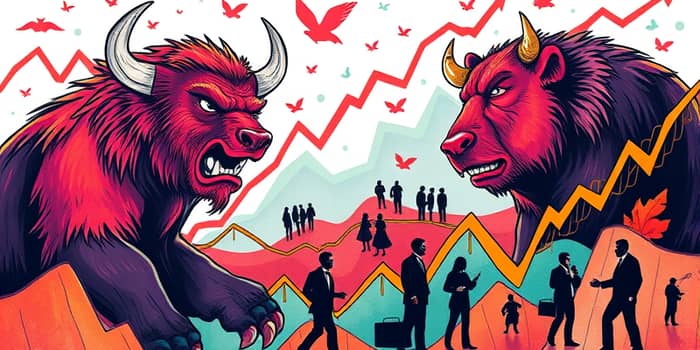Investor psychology and collective mood swings increasingly drive market dynamics, challenging traditional assumptions and creating opportunities.
Introduction to Sentiment and Behavior
Market sentiment reflects the prevailing attitude of investors toward risk, revealed by trading volumes and price trends. Behavioral finance examines how cognitive biases shape decision making, diverging from the notion of perfectly rational markets.
By combining these perspectives, we gain a deeper understanding of why prices sometimes defy fundamental valuations and why extreme ups and downs persist.
The Mechanics of Market Sentiment
Sentiment swings broadly fall into bullish or bearish categories. A bullish environment arises from optimism and expectations of rising prices, while bearish moods emerge from fear and anticipation of declines.
Some market participants, known as permabulls or permabears, maintain unshakable optimism or pessimism regardless of data. Their positions often influence broader trends, amplifying volatility when herd behavior intensifies.
At sentiment extremes, markets often reverse direction. Heavy optimism can precede downturns, whereas deep pessimism tends to signal potential rebounds, making extreme readings a useful contrarian market indicator.
Measuring Market Sentiment
Investors and analysts employ multiple tools to gauge mood. Technical indicators track market breadth, advanced/decline ratios, moving average crossovers, and momentum oscillators. Surveys capture investor expectations, while news analytics measure tone across financial media.
These measures, along with new highs vs. new lows data and automated textual analysis, offer a multifaceted view of collective psychology.
- Advance/Decline Ratios for market breadth
- Sentiment Surveys tracking investor outlooks
- News and social media analytics for tone
Key Biases in Behavioral Finance
Behavioral finance centers on cognitive biases first explored by Kahneman and Tversky. Among these, prospect theory highlights how people value gains and losses asymmetrically, fearing losses more than valuing equal gains.
Anchoring causes investors to cling to initial reference points when evaluating opportunities, while framing affects choices based on presentation. Overconfidence can drive excessive trading, and herding leads participants to follow consensus moves regardless of fundamentals.
Investors often exhibit loss aversion and overconfidence leading to churn and herding behavior in bubbles and crashes, reinforcing sentiment extremes and exacerbating price swings.
Real-World Examples and Market Outcomes
History is replete with episodes where sentiment overpowered fundamentals. During the late-1990s dot-com bubble, widespread enthusiasm for tech stocks led to astronomical valuations and ultimately a sharp collapse.
In 2008, extreme pessimism and fear of systemic failure drove selling into capitulation, only to see markets rebound once panic subsided. Similarly, the March 2020 COVID-19 crash reflected overwhelming fear, followed by a swift recovery as stimulus measures restored optimism.
- Dot-com bubble: irrational exuberance peaked in early 2000
- 2008 financial crisis: capitulation signals buying opportunities
- COVID-19 crash: fear-driven sell-off and rapid rebound
Strategies for Investors
Incorporating sentiment analysis into investment strategies can enhance timing and risk management. A contrarian strategy involves buying when sentiment is at multi-year lows and trimming positions at peaks of exuberance.
Regulators and institutions now recognize the impact of behavioral biases, with the SEC maintaining teams to study investor psychology and market responses.
- Monitor extreme sentiment readings for potential reversals
- Combine sentiment with fundamentals to validate trades
- Employ risk management when emotions dominate markets
Future Trends and Innovations
Advances in AI and machine learning models for sentiment analysis are refining our capacity to quantify mood in real time. Alternative data sources—social media, web traffic, news feeds—feed algorithms that detect nuance and predict sentiment shifts.
Integrating these insights into portfolio construction promises more resilient investment approaches that acknowledge both quantitative metrics and qualitative human factors.
Conclusion
Market sentiment and behavioral finance offer complementary lenses through which to view financial markets. While fundamentals remain essential, acknowledging emotional drivers behind market moves enables investors to navigate volatility more effectively.
By blending traditional analysis with sentiment metrics and an understanding of cognitive biases, participants can develop more holistic and adaptive investment strategies that thrive amid uncertainty.
References
- https://www.investopedia.com/terms/m/marketsentiment.asp
- https://corporatefinanceinstitute.com/resources/career-map/sell-side/capital-markets/market-sentiment/
- https://en.wikipedia.org/wiki/Market_sentiment
- https://www.bavest.co/en/post/market-psychology-and-sentiment
- https://www.investopedia.com/terms/b/behavioralfinance.asp
- https://imarticus.org/blog/understanding-behavioral-finance/
- https://www.tandfonline.com/doi/full/10.1080/1331677X.2018.1559748










